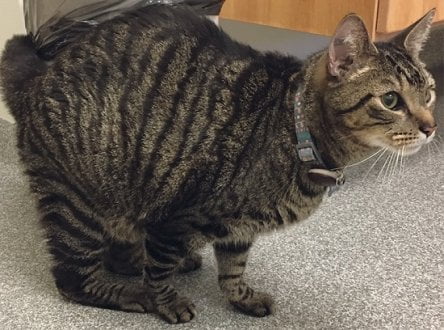Key Takeaways
Cats with diabetes may develop nerve damage in the legs. In many cases, feline diabetic neuropathy leads to hindlimb weakness, dropped hocks, and stumbling. Early recognition and coordinated veterinary care can slow progression. Home monitoring, supportive care, and consistent insulin plans improve comfort and function.
- Early signs: weak hind legs, plantigrade stance, and clumsy jumps.
- Diagnosis blends exam findings with glucose curves and labs.
- Treatment focuses on glycemic control and nerve support.
- Recovery varies; some cats regain strength with time.
Understanding Feline Diabetic Neuropathy
Prolonged hyperglycemia damages peripheral nerves, especially those serving the hind limbs. Axons and myelin can degenerate, reducing signal speed and muscle control. Cats often compensate quietly, so owners may notice subtle gait changes before overt weakness. Over months, reduced proprioception and muscle atrophy can appear.
Veterinarians describe a characteristic plantigrade stance (walking on the hocks) that reflects distal nerve dysfunction and muscle weakness. You might also see tremors after activity, flattened rear paws, or hesitation on stairs. Clear explanations and consistent routines help owners track small changes. Early, steady glucose regulation offers the best chance to stabilize function.
Early Signs and Progressive Symptoms
Owners often first notice altered gait, shorter jumps, or slipping on floors. Claws may drag, and the back legs can splay during turns. Appetite and thirst may increase due to diabetes, while weight drops despite eating more. These changes can precede more obvious weakness.
As deficits progress, cats may show Feline Diabetes Guide insights that contextualize daily behavior, which helps track trends. Describe clumsy landings, reduced grooming of the back half, or new litter box accidents. Mention any Diabetes Medications Overview you are using to your vet, because timing and types may influence signs. Clinicians use these observations alongside exams to narrow differentials such as orthopedic disease.
Some cases show feline diabetic neuropathy symptoms like hindlimb weakness and dropped hocks. Keep notes on onset and severity to support objective rechecks. Video clips can help your veterinarian assess day-to-day function you cannot replicate in clinic.
Why Back Legs Are Affected
Long nerves to the hind limbs are more vulnerable to metabolic injury. High glucose triggers sorbitol accumulation, oxidative stress, and impaired blood flow in small vessels that feed nerves. The result is slower conduction and impaired muscle control, most noticeable in weight-bearing tasks. This explains the classic low-hock posture during walking.
Clinically, the pattern often emphasizes extensor weakness and reduced withdrawal reflexes. You may notice knuckling or scuffing after longer activity. Many owners describe diabetic neuropathy in cats back legs with a tentative, wide-based stance. Physical therapy-style exercises, traction mats, and measured rest periods can reduce falls while treatment begins.
Diagnosis and Monitoring
Diagnosis combines a neurologic exam with diabetes testing. Your veterinarian may recommend fructosamine, serial glucose curves, and urinalysis to assess control. Electromyography or nerve conduction studies are rarely needed but can refine complex cases. Consistent records of food intake, water consumption, and activity guide clinical decisions at rechecks.
Home glucose checks offer trend data without stress hyperglycemia. For meter comparisons and calibration concepts, see OneTouch Verio Flex Meter to understand accuracy considerations. If you need lancets and fingerstick tips, review OneTouch Ultra Soft Lancets for device compatibility and sizing information. Ask your vet what is dangerously high blood sugar for a cat based on your cat’s history and current plan.
Clinical guidelines provide structure for targets and testing intervals. For a framework on monitoring, dosing adjustments, and curves, the AAHA diabetes guidelines summarize common protocols. For disease background and neurological signs, the Merck Veterinary Manual offers a concise overview.
Treatment Options and Home Care
The cornerstone of care is stable glycemic control. Your veterinarian may recommend insulin and diet changes alongside weight management and hydration support. For product formulation details, see ProZinc Vial and Caninsulin Vial; discuss suitability and dosing with your clinic. Smooth routines, fixed feeding times, and consistent injection technique help reduce variability.
Equipment choice and technique matter. Needle selection affects comfort, so review the BD Needles Guide for sizing concepts and safe disposal. As function improves, add traction rugs, low-sided litter boxes, and raised dishes to conserve energy. Well-planned rest and low-impact play can maintain muscle without strain. Any changes to medications should follow veterinary advice.
Work with your team to decide on treatment for diabetic neuropathy in cats alongside overall diabetes control. Combining good glucose management with supportive care often yields the best functional outcomes.
Supplements and Nerve Support
Nutraceuticals may complement medical therapy. Methylcobalamin (a bioactive form of vitamin B12) supports myelin integrity and nerve repair processes. Some clinicians add omega-3s for anti-inflammatory support and antioxidants for cellular defense. Evidence is evolving, so discuss expected benefits and monitoring with your veterinarian before starting supplements.
When discussing options, ask about vitamin b12 for cats with neuropathy and how it might fit your plan. Keep expectations conservative and track small functional gains over weeks. If analgesia is required for neuropathic discomfort, your vet may consider adjuncts. For formulation references, see Gabapentin and similar resources; use only under veterinary guidance.
Prognosis and Remission
Outcomes vary with disease duration, severity, and control quality. Nerves regenerate slowly, so improvements often lag behind glucose stabilization. Some cats show clearer steps, stronger jumps, or a more normal paw set after sustained control. Others plateau with stable but persistent weakness.
Many owners ask, can diabetic neuropathy in cats be reversed as control improves. Partial recovery is possible when hyperglycemia is addressed early and consistently. Remission from diabetes occurs in a subset of cats, often with prompt diagnosis and weight management. Watch for gradual reductions in thirst, improved energy, and steadier weights as encouraging signs over time.
End-of-Life Considerations
Advanced disease can severely limit mobility, grooming, and litter use. Quality-of-life scoring helps frame decisions when daily function declines. Pain, distress, or repeated injuries from falls deserve careful attention. Discuss environmental modifications and supportive devices before considering final options.
Owners sometimes wonder, should i euthanize my cat with diabetes when complications feel overwhelming. Decisions should be guided by comfort, response to therapy, and veterinary counsel. Palliative steps may improve dignity and reduce stress for both cat and caregiver. Revisit goals regularly and involve the family in shared decision-making.
Prevention and Daily Management
Stable routines and careful monitoring reduce risk for nerve injury. Keep feeding times consistent and track water intake and weight monthly. Use home logs to capture glucose trends and activity notes. Adjust the environment with ramps, non-slip mats, and easy-access litter boxes.
Understand diabetic cat behavior patterns, such as increased nocturnal thirst or changes in play. For testing cadence and technique tips, review Monitor Blood Sugar Frequency for context on intervals and goals. Regular rechecks with your veterinarian refine the plan as the cat’s needs evolve. Staying proactive helps preserve strength and comfort.
Recap
Nerve damage related to diabetes can compromise mobility and comfort. With structured monitoring, consistent insulin routines, and targeted support, many cats stabilize and function well at home. Track changes, collaborate with your veterinary team, and adjust care as needs shift. Small, steady improvements often add up over time.
Note: Sudden weakness, collapse, or behavior change warrants prompt veterinary attention, especially in diabetic cats.
This content is for informational purposes only and is not a substitute for professional medical advice.


